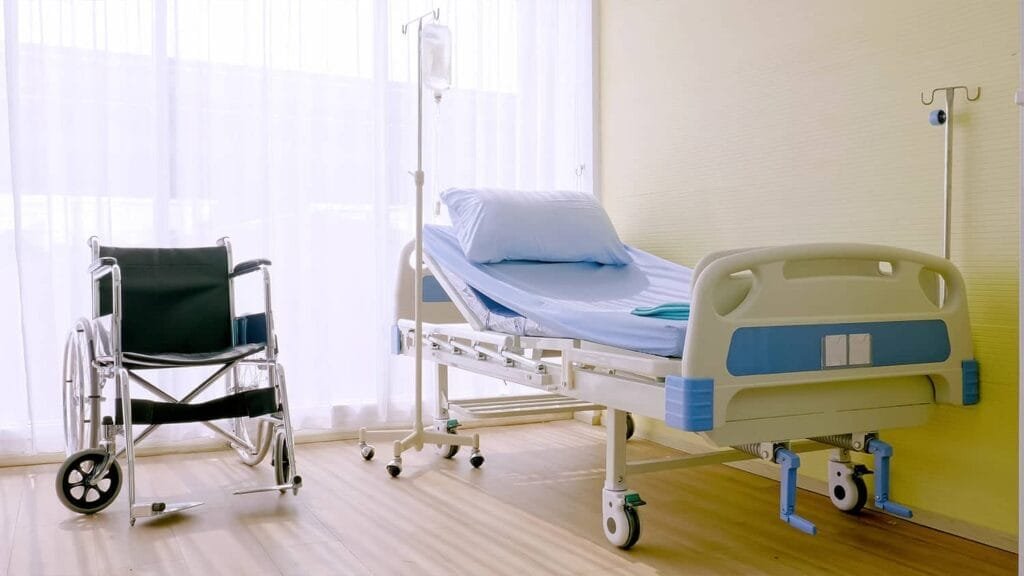Indirizzo
304 Il cardinale nord S.
Dorchester Center, MA 02124
Ore di lavoro
Dal lunedì al venerdì: 7:00 - 19:00
Fine settimana: 10:00 - 17:00
Indirizzo
304 Il cardinale nord S.
Dorchester Center, MA 02124
Ore di lavoro
Dal lunedì al venerdì: 7:00 - 19:00
Fine settimana: 10:00 - 17:00

Recovering from a medical condition, surgery, or managing chronic illnesses can be a challenging process, especially when it involves extended periods of bed rest. A home care hospital bed can significantly improve the quality of recovery by providing comfort, safety, and functionality that standard beds simply cannot offer. This blog post explores the top benefits of a home care hospital bed for recovery, emphasizing its role in enhancing patient care at home.
Benvenuti nel mio blog!
Prima di immergerci nei contenuti, mi piacerebbe che ti unissi a me sulle mie piattaforme social, dove condivido altre intuizioni, interagisco con la community e pubblico aggiornamenti. Ecco come puoi metterti in contatto con me:
Facebook: https://www.facebook.com/profile.php?id=100071234835011
LinkedIn: https://www.linkedin.com/company/74943205/admin/dashboard/
YouTube: www.youtube.com/@shandongexpertmedicalequip4695
TikTok: www.tiktok.com/@expertmedical
Ora, iniziamo il nostro viaggio insieme. Spero che tu trovi il contenuto qui perspicace, coinvolgente e prezioso.
Recovering from a medical condition, surgery, or managing chronic illnesses can be a challenging process, especially when it involves extended periods of bed rest. A home care hospital bed can significantly improve the quality of recovery by providing comfort, safety, and functionality that standard beds simply cannot offer. This blog post explores the top benefits of a home care hospital bed for recovery, emphasizing its role in enhancing patient care at home.

When recovering at home, one of the most important considerations is the type of bed used. A hospital bed, designed specifically for patient care, offers numerous advantages over a regular bed. These beds are equipped with features that can help prevent complications, improve comfort, and facilitate care, making them an ideal choice for home recovery.
In this section, we will introduce the concept of a home care hospital bed and discuss why it is a beneficial investment for those needing long-term care at home.
A hospital bed is a specially designed bed that can be adjusted in various ways to accommodate the needs of patients. These beds can elevate the head, foot, and middle sections, allowing for different positions that aid in comfort and medical needs. Home care hospital beds are versions of these beds that are suitable for home use, offering the same functionality in a more domestic setting.
Choosing a hospital bed for home use is not just about comfort; it’s about ensuring that the recovery environment is safe and conducive to healing. Whether it’s for post-surgery recovery, managing a chronic illness, or providing palliative care, a hospital bed offers multiple benefits that can make a significant difference in the recovery process.
One of the primary benefits of using a hospital bed at home is the enhanced comfort it provides. Recovery often involves prolonged periods of lying down, which can lead to discomfort, pain, and pressure sores if not managed properly. Hospital beds are designed with features that alleviate these issues.
Hospital beds allow for adjustments in the head, foot, and middle sections, which can be controlled either manually or electronically. This adjustability helps patients find the most comfortable position, whether they are resting, eating, or engaging in light activities like reading or watching TV. The ability to change positions easily can reduce the risk of bedsores and alleviate pain associated with prolonged immobility.
Chronic pain and pressure sores are common issues for those confined to bed rest. A hospital bed’s adjustable features can help manage these problems by allowing the patient to shift weight and reduce pressure on vulnerable areas. This can be especially beneficial for patients with conditions like arthritis, spinal injuries, or those recovering from surgery.
Another significant advantage of a hospital bed is its role in improving patient mobility and independence. For individuals with limited mobility, getting in and out of a regular bed can be challenging and sometimes dangerous. Hospital beds are designed to mitigate these risks.
Hospital beds are equipped with side rails and adjustable heights, making it easier for patients to get in and out of bed safely. The side rails provide support when moving or adjusting positions, reducing the risk of falls. For caregivers, these features also make it easier to assist patients without straining their own bodies.
The ability to adjust the bed’s height and angle makes it easier for patients to perform daily activities such as eating, bathing, and dressing with minimal assistance. This level of independence is crucial for maintaining dignity and self-esteem during recovery.
Hospital beds are not just beneficial for patients; they also offer significant advantages for caregivers. Caring for someone with limited mobility or chronic illness can be physically demanding, and hospital beds can help ease this burden.
The adjustable height of a hospital bed allows caregivers to work at a comfortable level, reducing the risk of back injuries. Caregivers can raise the bed to a suitable height for dressing wounds, assisting with personal hygiene, or moving the patient, minimizing physical strain.
With the help of a hospital bed, caregivers can provide better care. The ease of positioning the patient properly aids in performing medical tasks such as administering medications, changing bandages, or conducting physical therapy. This can lead to improved outcomes and faster recovery times.
Hospital beds are designed with medical functionality in mind, which is crucial for patients recovering at home. These beds can support various medical needs that standard beds cannot accommodate.
For patients requiring frequent medical attention, such as wound care, injections, or physiotherapy, a hospital bed provides the necessary support. The adjustable features allow for optimal positioning during procedures, ensuring both patient comfort and caregiver access.
Many hospital beds come with the ability to attach medical equipment, such as IV poles, over-bed tables, or monitors. This makes it easier to manage complex medical needs without the patient needing to be moved frequently, which can be both uncomfortable and risky.

In the past, hospital beds were often associated with sterile, clinical environments. However, modern home care hospital beds have evolved to combine functionality with aesthetics, making them suitable for home settings.
Today’s hospital beds come in various designs and finishes that can blend seamlessly with home decor. From wooden finishes to contemporary designs, these beds no longer have to look out of place in a home setting.
Many hospital beds are equipped with quiet motors and advanced technology that allow for smooth, noise-free adjustments. This feature is particularly beneficial for maintaining a peaceful environment, which is essential for recovery.
To better understand the various features available in hospital beds, here is a comparison table highlighting key aspects that can be considered when selecting a bed for home care:
| Caratteristica | Basic Hospital Bed | Semi-Electric Hospital Bed | Full-Electric Hospital Bed |
|---|---|---|---|
| Adattabilità | Manuale | Manuale/Elettrico | Full Electric |
| Regolazione altezza | Limitato | Regolabile | Fully Adjustable |
| Sponde laterali | Fisso | Rimovibile | Rimovibile |
| Bed Frame Material | Steel | Steel/Wood | Steel/Wood |
| Motor Noise Level | No Motor | Moderare | Quiet |
| Compatibility with Equipment | Di base | Moderare | Alto |
| Aesthetic Options | Limitato | Moderare | Wide Range |
| Cost Range | Basso | Moderare | Alto |
This table provides a clear overview of what to expect from different types of hospital beds, helping you choose the one that best suits your needs.
Investing in a hospital bed for home care is an important decision that can significantly impact the recovery process. The benefits of comfort, mobility, and enhanced medical care provided by a hospital bed are invaluable for anyone recovering from surgery, illness, or managing a chronic condition at home. By choosing the right bed, you can create a recovery environment that promotes healing, supports caregivers, and maintains the dignity and independence of the patient.
A hospital bed is specifically designed for patient care, with features like adjustable sections, side rails, and compatibility with medical equipment. These features are not typically found in regular beds, making hospital beds more suitable for individuals with specific medical needs.
Yes, hospital beds are available for home use and are often recommended for individuals recovering from surgery, dealing with chronic illness, or requiring long-term care. Home care hospital beds are designed to offer the same functionality as those in hospitals but with features that make them suitable for a home environment.
When choosing a hospital bed for home care, consider factors such as the patient’s medical needs, the level of adjustability required, aesthetic preferences, and budget. It’s also important to consult with healthcare providers to ensure the bed meets the specific needs of the patient.
In many cases, hospital beds are covered by insurance if they are deemed medically necessary. It’s important to check with your insurance provider to understand the specific coverage and any documentation required to qualify for reimbursement.
Maintaining a hospital bed involves regular cleaning, checking the functionality of the motors and adjustability features, and ensuring that any attached medical equipment is working properly. It’s also important to follow the manufacturer’s guidelines for maintenance and repairs.